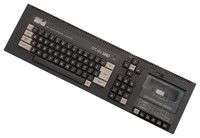Spanish Amstrad CPC 464 (Schneider Keys & Cassette Deck)
| Home > Browse Our Collection > Computers > Amstrad > Spanish Amstrad CPC 4 ... Keys & Cassette Deck) |
|
This is a late model of the CPC 464, and dates from after the deal with the German company Schneider ended in 1987. In 1984 Amstrad had entered a partnership with Schneider Rundfunkwerke AG, a German company, to manufacture and distribute the CPC 464 in the German, Austrian and Swiss markets. Following the deal the Schneider Computer Division company was created, and the Amstrad CPC line was branded and sold as the Schneider CPC. When the deal ended it led to lots of spare parts being created, especially keyboards and tape drives. This is one such machine, a UK case fitted with the grey Schneider keys, and the German cassette deck, but with a UK label, and Spanish and English names on the ports. The Amstrad CPC 464 was one of the most successful computers in Europe. More than two million computers were sold. Despite its ordinary characteristics (like those of the Sinclair Spectrum and often less interesting than those of the others like the Commodore 64 or Atari XL/Xe series) or odd features (like video memory or strange floppy disk format), it was very popular because of its really low price and its interesting commercial concept : all peripherals were sold together (like the Commodore PET that was sold years earlier): CPU/keyboard, tape recorder, monitor (monochrome green or colour). A huge number of programs and peripherals were developed for this machine. It ran AmsDos (Amstrad's Operating System). AmsDos was completely embedded in the Basic using so-called RSX commands starting with |, but it could not format disks, you needed a special application for that. The 464 also could use CP/M 2.2 or 3.0 when used with an external Floppy disk unit (3-inch Hitachi, 180 KB / face). A lot of great CP/M software was adapted for the Amstrad CPC. About 42 KB RAM was available for the user, the video memory and the ROM were mapped on the same addresses with a dedicated chip to switch the memory banks automatically. Notice that the first Amstrad CPC prototype (called "Arnold", which gave the name ROLAND (Arnold acronym) to several CPC games) was built around a 6502 processor and then changed to a Z80 late in the computer’s development. A few months later, the CPC series would be completed with a computer which offered a built-in floppy disk unit: the CPC 664. The MP-3 Modulator Convertor. This was NOT an MP3 player by Amstrad, yet it was quite a nice product to have. It was a device that you could connect to your monitor and turn it into a nice television set for your bedroom. Quality and reception was not stellar, but still it was very good value for money. Don't imagine any fancy stuff like watching TV in a window or anything - the tuner just used the monitor for its output. It was an interesting reversal of logic: the CPCs shipped with monitors in order to free the home TV from computer use - and then was turned into a TV set itself. Manufacturer: Amstrad Comment on This Page Other Systems Related To Spanish Amstrad CPC 464 (Schneider Keys & Cassette Deck):This exhibit has a reference ID of CH63900. Please quote this reference ID in any communication with the Centre for Computing History. |
|



























